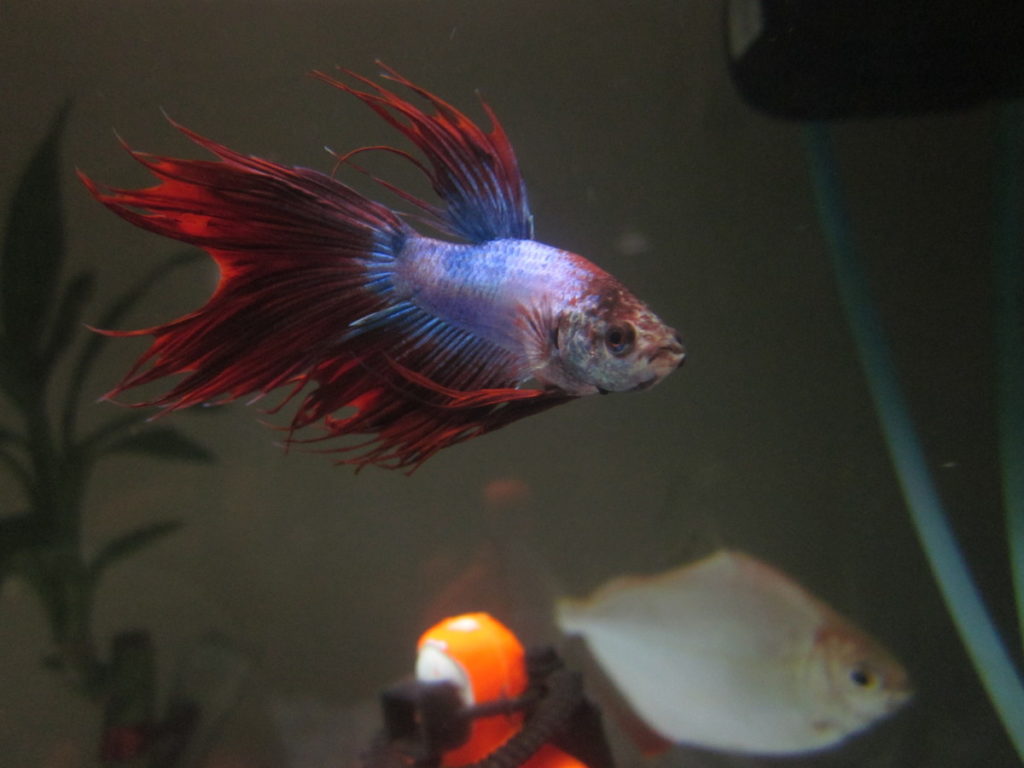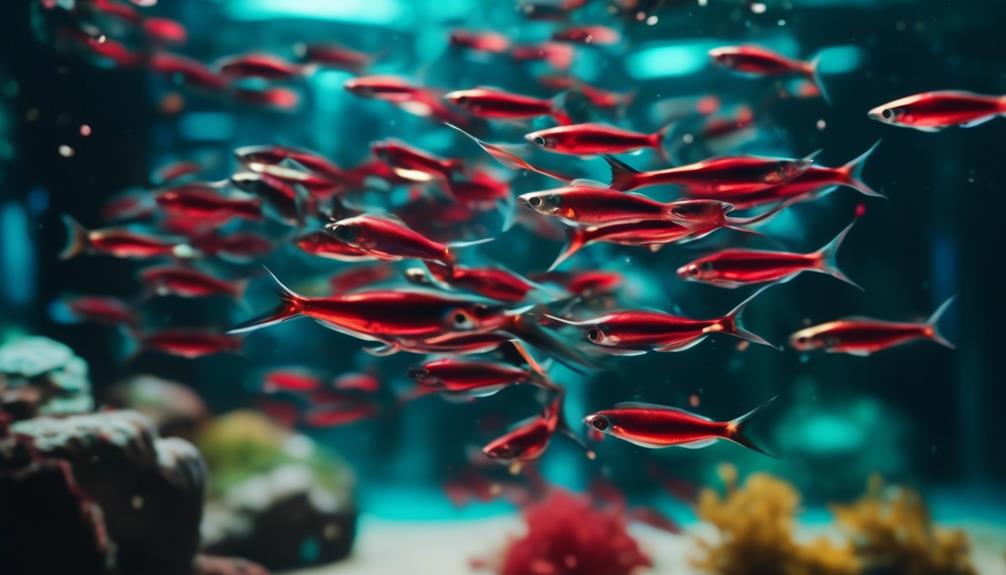
Step into the mesmerizing world of pencilfish, where vibrant colors and graceful movements come together in a dazzling display. Like a painter’s palette, these small freshwater fish will bring life and energy to your aquarium.
But there’s more to pencilfish than just their striking appearance. From their natural habitat in the rivers of South America to their peaceful nature and compatibility with other fish, there’s a whole story waiting to be unraveled.
So, grab your snorkel and get ready to plunge into the depths of knowledge about these captivating creatures, as we explore their origins, behavior, and care requirements.
Key Takeaways
- Pencilfish are small freshwater fish native to South America.
- They exhibit gold or iridescent coloration with black stripes and splashes of red, orange, or maroon in their fins and body.
- Pencilfish are peaceful and suitable for community tanks, making them compatible with various tank mates such as tetras, barbs, rasboras, guppies, mollies, swordtails, and other small community fish.
- They require warm, soft, slightly acidic water with a pH range between 5.5 and 7.0 and a temperature range between 72F and 82F.
Pencilfish Introduction
Pencilfish, native to the tributaries of various river systems in South America, are colorful and peaceful freshwater fish that make a beautiful addition to small aquariums.
These fish come in a variety of species, including Golden Pencilfishes, Two-Stripe Pencilfishes, Brown Pencilfishes, Dwarf Pencilfishes, Shining Pencilfishes, Three-Stripe Pencilfishes, and One-Line Pencilfishes. They’re small in size, generally growing no more than 2 inches long.
Pencilfish exhibit gold or iridescent coloration with black stripes and splashes of red, orange, or maroon in their fins and body. They’ve a peaceful temperament, making them suitable for community tanks.
Pencilfish require warm, soft, slightly acidic water conditions in the aquarium. With their vibrant colors and calm nature, Pencilfish are a delightful choice for aquarium enthusiasts.
Pencilfish General Description
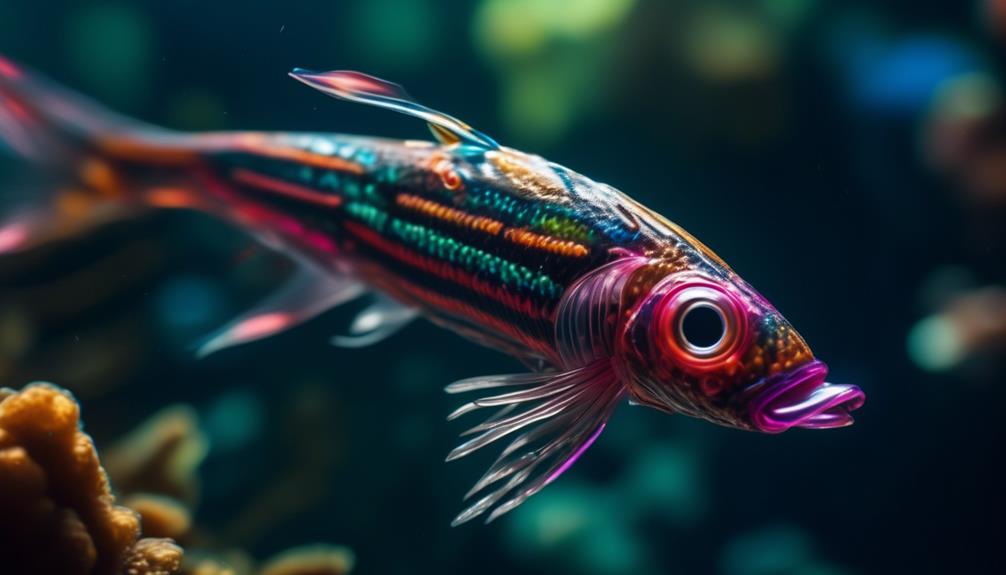
As we move into discussing the subtopic of Pencilfish General Description, let’s explore the captivating features and characteristics that make these small freshwater fish a popular choice for aquarium enthusiasts.
| Characteristics | Description | Examples |
|---|---|---|
| Origins | Native to tributaries of various river systems in South America | Rio Negro Pencilfish, Xingu Pencilfish |
| Color | Exhibit gold or iridescent coloration with black stripes and splashes of red, orange, or maroon in fins and body | Golden Pencilfish, Red Stripe Pencilfish |
| Temperament | Peaceful and suitable for community tanks | Shining Pencilfish, Dwarf Pencilfish |
| Water Condition | Warm, soft, slightly acidic water | Two-Stripe Pencilfish, Brown Pencilfish |
| Size | Generally grow no more than 2 inches long | Three-Stripe Pencilfish, One-Line Pencilfish |
Pencilfish come in various species, each with its own unique coloration and pattern. They are peaceful and can be kept with other small community fish. These fish thrive in warm, soft, and slightly acidic water conditions. With their small size, they make a great addition to smaller aquariums.
Pencilfish Varieties
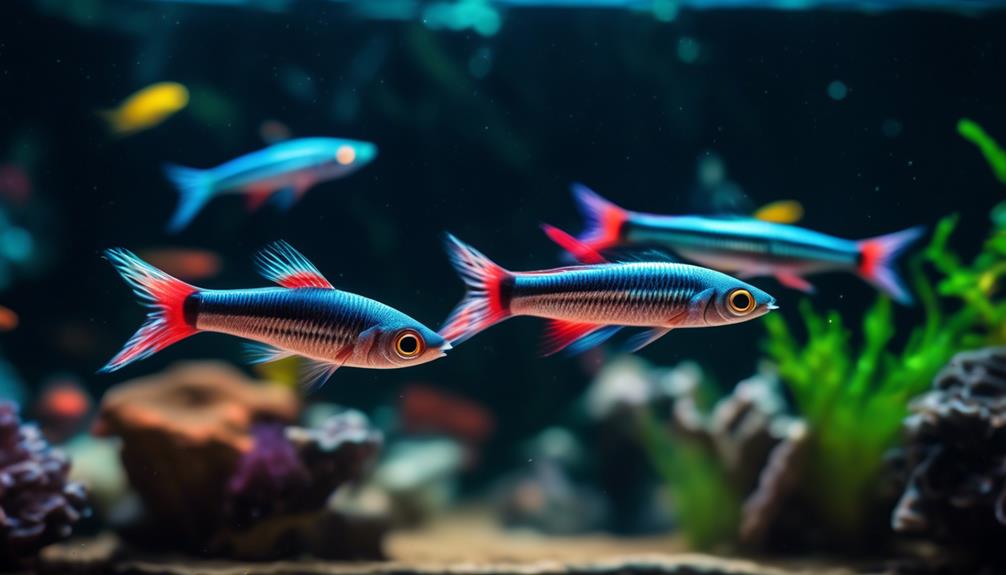
There are 19 different species of pencilfish, each with its own unique characteristics and coloring. To paint a picture for you, here are three varieties of pencilfish to explore:
- Golden Pencilfishes: These stunning fish display a golden coloration, with black stripes adding a touch of elegance. Their fins may also feature splashes of red or orange, creating a beautiful contrast.
- Two-Stripe Pencilfishes: As their name suggests, these pencilfish have two distinct black stripes running along their body. The stripes stand out against their iridescent gold or silver coloration, giving them a striking appearance.
- Brown Pencilfishes: With a more subdued coloration, these pencilfish are known for their earthy brown tones. They may have subtle patterns on their body, adding a touch of complexity to their overall appearance.
These are just a few examples of the diverse and captivating pencilfish varieties you can find in the aquarium hobby.
Pencilfish Characteristics
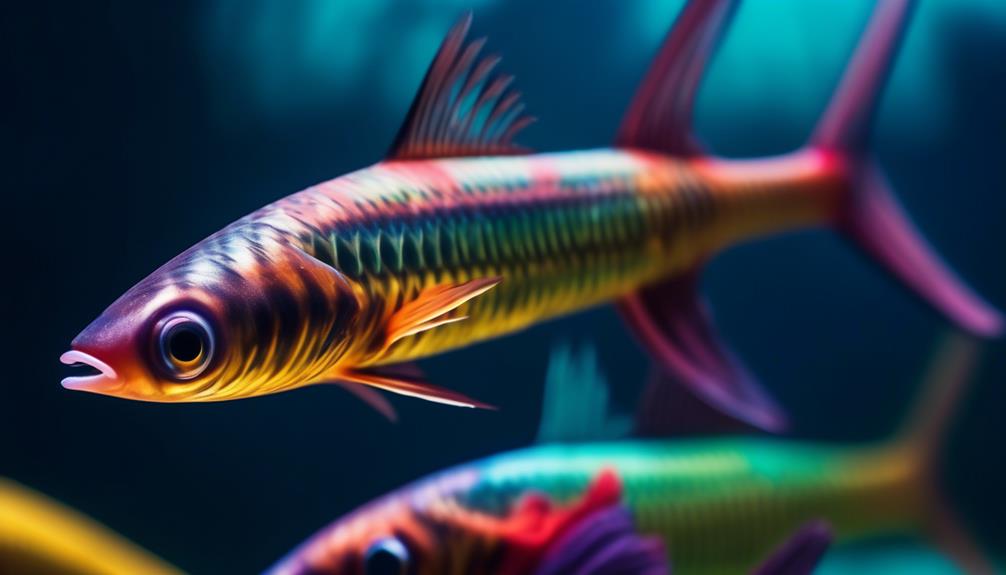
Pencilfish exhibit vibrant colors and peaceful temperament, making them an ideal choice for community tanks. These small freshwater fish are known for their stunning gold or iridescent coloration with black stripes, along with splashes of red, orange, or maroon on their fins and body.
They’re suitable tank mates for tetras, barbs, rasboras, guppies, mollies, swordtails, and other small community fish. Pencilfish thrive in warm, soft, and slightly acidic water conditions. To keep them happy and healthy, provide a tank with live plants, driftwood, and rockwork for hiding places.
They accept a variety of high-quality commercial foods, as well as fresh and frozen options like brine shrimp, algae wafers, and fresh vegetation. With their peaceful nature and stunning colors, pencilfish are a wonderful addition to any community tank.
Pencilfish Tank Requirements
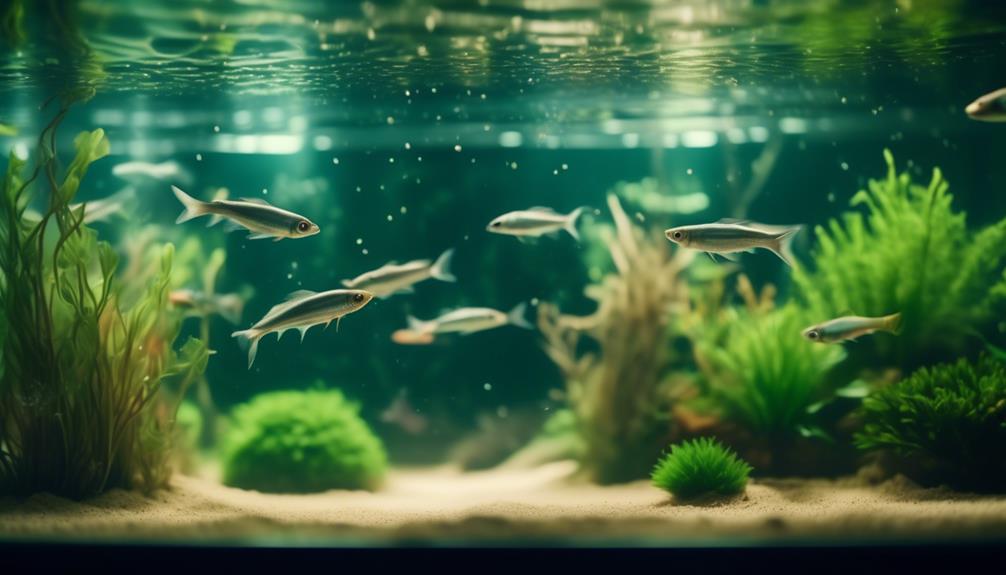
To ensure the well-being of your pencilfish, it’s important to meet their specific tank requirements. Here are three key factors to consider:
- Tank Size: Pencilfish are small fish, so a small aquarium will suffice. A tank with a capacity of at least 10 gallons is recommended to provide enough swimming space for a small group of pencilfish.
- Water Conditions: Pencilfish thrive in warm, soft, and slightly acidic water. Maintain a pH range between 5.5 and 7.0 and a temperature range between 72°F and 82°F. Regular water changes are necessary to prevent nitrate build-up.
- Tank Decoration: Provide live plants, driftwood, and rockwork for hiding places and to mimic their natural habitat. Pencilfish feel more secure when they’ve places to retreat and explore.
Pencilfish Feeding
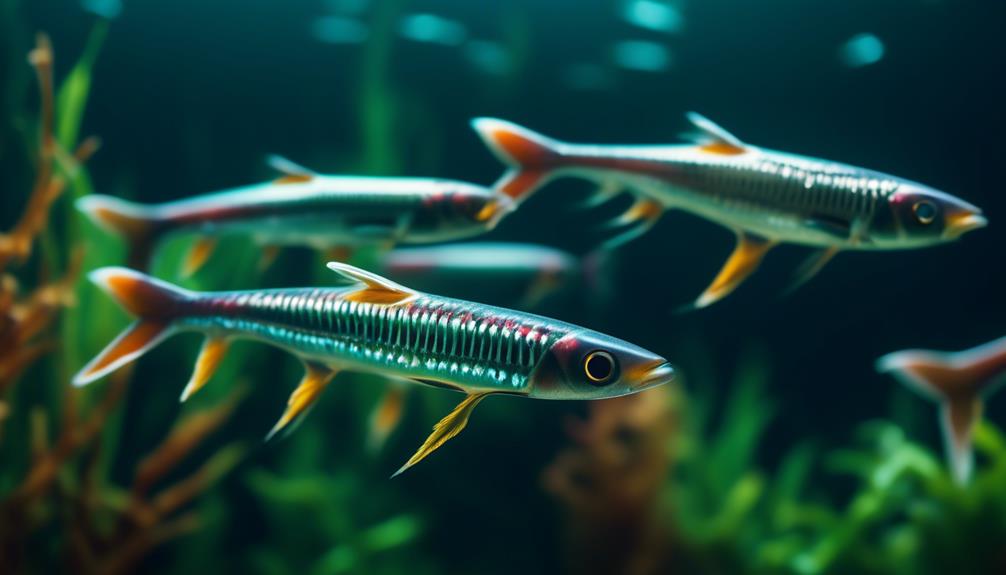
Now that you have set up the tank to meet the specific requirements of your pencilfish, it’s important to understand their dietary needs and how to properly feed them. Pencilfish are not picky eaters and will readily accept a variety of high-quality commercial foods. It’s also beneficial to supplement their diet with fresh and frozen foods, such as brine shrimp and algae wafers. Additionally, including fresh vegetation in their diet is recommended. To help you better understand the feeding requirements of pencilfish, here is a table outlining their dietary needs:
| Food Type | Frequency |
|---|---|
| High-quality pellets | Daily |
| Brine shrimp | 2-3 times a week |
| Algae wafers | 2-3 times a week |
| Fresh vegetables | Once a week |
Pencilfish Breeding
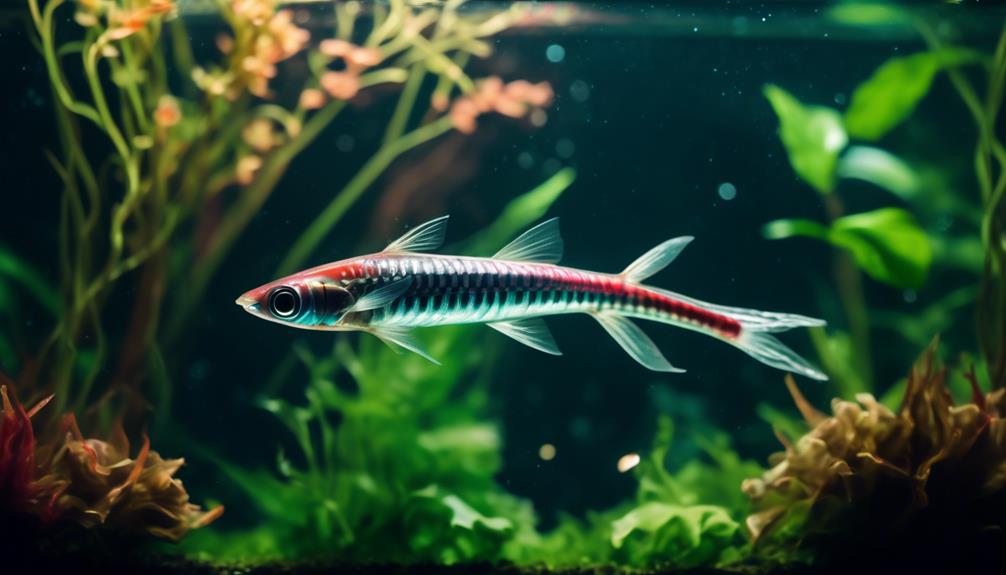
To successfully breed pencilfish, it’s important to create a separate breeding tank for them. Here are three important things to consider when breeding pencilfish:
- Provide plenty of hiding places: Pencilfish are shy breeders and prefer to lay their eggs in plants or among fine-leaved vegetation. Make sure to include plenty of plants, driftwood, and rockwork in the breeding tank to create hiding places for the fish.
- Maintain optimal water conditions: Pencilfish prefer warm, soft, and slightly acidic water for breeding. Keep the temperature between 72°F and 82°F and maintain a pH range between 5.5 and 7.0. Regular water changes are essential to ensure good water quality.
- Separate the parents from the eggs and fry: Once the eggs are laid, the parents may eat them or the fry. To protect the eggs and fry, it’s important to separate the parents from the breeding tank after spawning. This can be done by transferring the adult fish back to the community tank.
Pencilfish Maintenance and Care
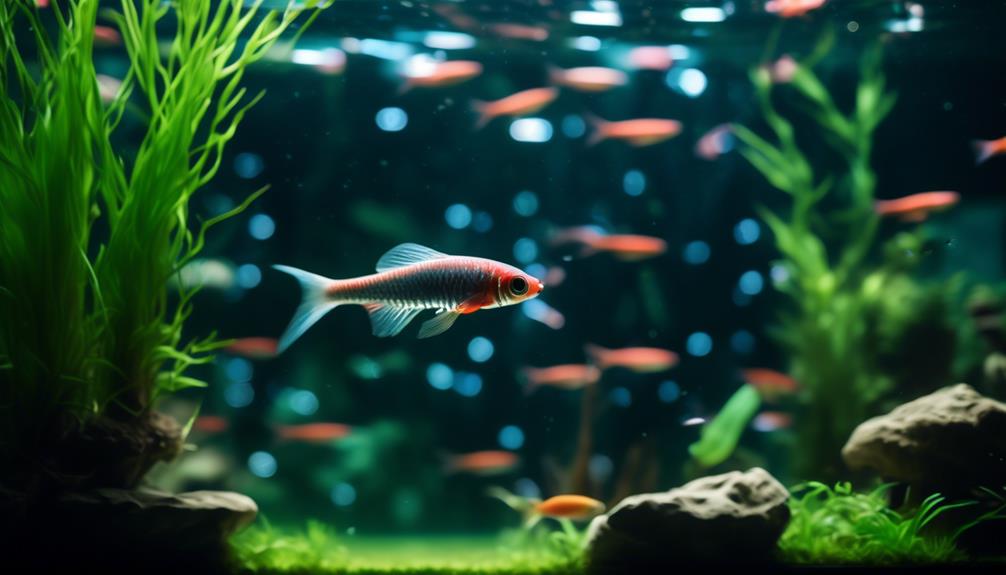
Taking care of pencilfish is essential for their health and well-being. To ensure their optimal care, it’s important to provide them with a suitable tank environment.
Pencilfish thrive in soft, slightly acidic water with a pH range between 5.5 and 7.0, and a temperature range between 72F and 82F. Live plants, driftwood, and rockwork should be included in the tank to create hiding places for the fish.
Regular water changes are necessary to maintain proper nitrate levels, as pencilfish are sensitive to high levels of nitrate. It’s also important to have a tank cover to prevent them from jumping out.
Pencilfish are generally easy to feed, accepting a variety of high-quality commercial foods, as well as fresh and frozen foods such as brine shrimp, algae wafers, and fresh vegetation.
Pencilfish Information Sources
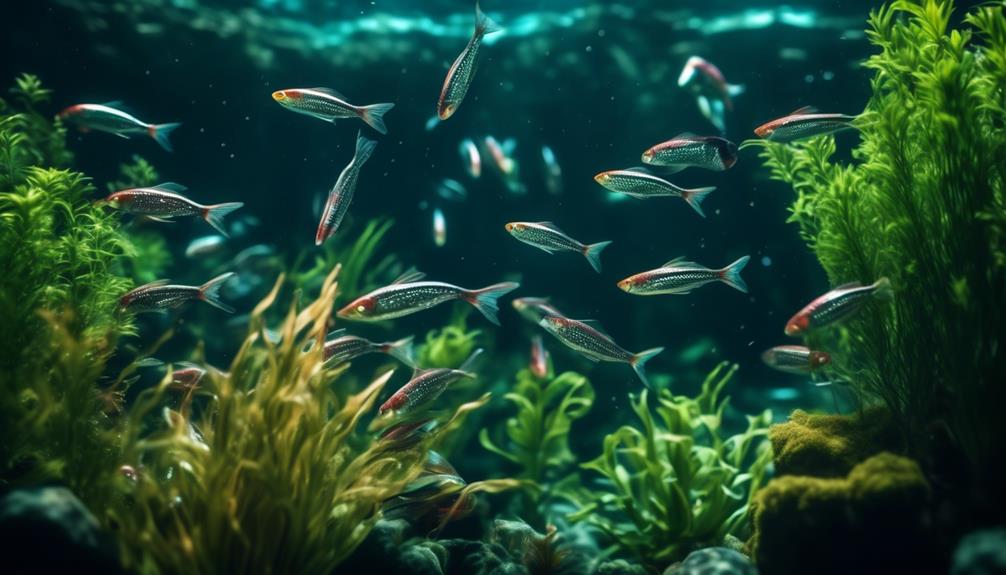
For detailed information on pencilfish, PetGuide is a reliable source that provides in-depth knowledge about this unique breed of fish.
When researching pencilfish, it’s important to have access to accurate and trustworthy information. PetGuide offers valuable insights into the characteristics, care, and breeding of pencilfish.
The website includes detailed descriptions of the various pencilfish varieties, such as Golden Pencilfishes, Two-Stripe Pencilfishes, and Brown Pencilfishes, allowing you to better understand their distinct features.
Additionally, PetGuide provides information on suitable tank mates for pencilfish, such as tetras, barbs, and rasboras, ensuring a harmonious community tank.
With the help of PetGuide, you can confidently navigate the colorful world of pencilfish and provide the best care for these fascinating creatures.
Frequently Asked Questions
How Long Do Pencilfish Live?
Pencilfish can live for around 3-5 years if properly cared for. Provide them with a suitable tank environment, including warm, soft, slightly acidic water, and a balanced diet.
Are Pencilfish Suitable for Beginners?
Yes, pencilfish are suitable for beginners. They are peaceful and can be kept in small aquariums. They have colorful gold or iridescent bodies with black stripes and splashes of red, orange, or maroon.
Can Pencilfish Be Kept in a Planted Tank?
Yes, pencilfish can be kept in a planted tank. They enjoy the natural environment provided by live plants and they will appreciate the hiding places they offer. Just make sure to choose plants that can thrive in their warm, slightly acidic water.
Do Pencilfish Shoal or Prefer to Be Kept in Pairs?
Pencilfish prefer to be kept in small groups rather than pairs. They are shoaling fish and feel more secure and less stressed when in the company of their own kind.
Are Pencilfish Jumpers and Do They Require a Tank Cover?
Yes, pencilfish are jumpers and it is important to have a tank cover to prevent them from escaping. This will ensure the safety of your fish and keep them secure in their habitat.
Are Pencilfish and Blennies Compatible in the Same Aquarium?
Pencilfish and Blennies are both peaceful freshwater species, making them compatible tankmates. However, ensure the aquarium is large enough to accommodate both, as Blennies can be territorial. Despite this, the colorful world of blennies and the graceful nature of pencilfish can create a harmonious underwater environment.
Conclusion
So, if you’re looking to add a burst of color to your aquarium, pencilfish are the perfect choice. With their vibrant hues and peaceful temperament, these small freshwater fish will bring life and beauty to your tank.
From their origins in South America to their unique breeding process, pencilfish are truly fascinating creatures.
With the right care and maintenance, you can enjoy the beauty of these exquisite fish for years to come.
Dive into the world of pencilfish and unlock a whole new level of aquarium beauty.

